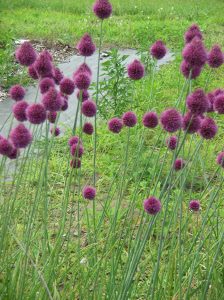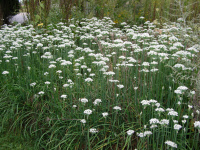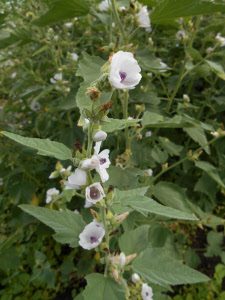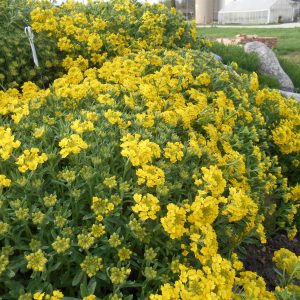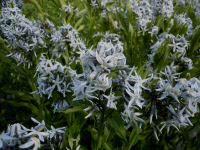Perennials & Biennials
Showing 25–32 of 511 results
-
Allium senescens Corkscrew allium, German garlic, Greater mountain garlic Z 4-9
Lavender balls, up to 30 of them, atop thin, bluish, strap-like, twisting foliage – mid-summer day’s dream.
Lavender balls, up to 30 of them, atop thin, bluish, strap-like, twisting foliage – mid-summer day’s dream.
Size: 6-12” x 6-12”
Care: sun to part shade in well-drained to moist well-drained soil
Native: Siberia
Wildlife Value: attracts butterflies & bees, deer & rabbit resistantCultivated before 1753. According to Philip Miller’s 1768 Dictionary, “planted in gardens for the variety of their flowers.”
-
Allium sphaerocephalon Drumstick allium Z 4-11
Claret colored, egg shaped flower heads
Claret colored, egg shaped flower heads top leafless stems in June to July. Good see-through plant to intermingle with purple coneflowers or tickseed. Good cut flower. Self-sows
Size: 2-3’ x 2-3”
Care: sun in well-drained to moist well-drained soil.
Native: Mediterranean, Caucasus & Europe
Wildlife Value: attracts bees, butterflies and other insects.In gardens before 1750. Used as an edging around vegetables at Mount Vernon.
-
Allium tuberosum Garlic chives
August & September bright white balls the size of golf balls on erect stems. Pretty in fall gardens.
August & September bright white balls the size of golf balls on erect stems. Pretty in fall gardens.
Size: 12-18” x 8”
Care: Full sun or shade in any soil
Native: SW Shanxi China
Wildlife Value: nectar source for many butterlies including the Tiger Swallowtail.Used medicinally in Asia as a remedy for incontinence, bladder weakness, kidney trouble and knee injuries. Traditional Chinese medicine practitioners made a powder from the seeds called Jiu Cai Zi used for numerous ailments. Widely grown as a vegetable.
-
Althaea officinalis Marshmallow Z 4-9
Small pale pink mallow-like blooms climb tall spires from July to September
Small pale pink mallow-like blooms climb tall spires from July to September
Size: 5-6’ x 3’
Care: Full sun moist to moist well-drained fertile soil. Heat and drought tolerant, stands up to wind.
Native: Central, south and east EuropeAlthaea is Greek meaning “to cure.” This was identified by Dioscorides in De Materica Medica for medicinal use around 70 A.D. More than 2000 years ago ancient Egyptians added honey to the cooked root. Ancient Romans used leaves and flowers as a strewing herb to repel lice and fleas. Emperor Charlemagne (742-814) cultivated the marshmallow in his gardens. According to Nicholas Culpepper, 16th century English herbalist, marshmallows were a medicinal candy. The plant eased pain, helped bloody fluxes, the stone and gravel and gripping of the belly. The marshmallow was considered to be an herb of Venus meaning that it voided offensive humors, made milk for nursing, cured bee stings, dandruff, balding and coughs. The French concocted the fluffy white confection in the mid 1800’s “from a decoction of marshmallow root, with gum to bind the ingredients together, beaten egg white to give lightness and to act as a drying agent, while sugar was incorporated to make the whole palatable.” American gardens since 1700’s when John Bartram (1699-1777) received seeds from Europe. Jefferson grew it at Monticello. Grown at America’s 1st botanic garden, Elgin Botanic Garden 1811.
-
Alyssum wulfenianum syn. Alyssum ovirense Alpine alyssum, Madwort Z 3-9
Spring to early summer, clumps of sunny yellow blooms over gray foliage
OUT OF STOCK
Spring to early summer, clumps of sunny yellow blooms over gray foliage
Size: 4-6” x 12-18”
Care: sun in well-drained soil
Native: GermanyDescribed in Willdenow’s Enum. pl. suppl. Before 1814. Grown at the Agricultural Center in Beltsville Maryland in 1897.
-
Amsonia hubrichtii Thread leaf amsonia, Arkansas amsonia Z 5-8
Powder-blue flowers of terminal clusters in early summer; feathery, thin,”threadleaf” foliage turns caution-sign yellow in fall.
Powder-blue flowers of terminal clusters in early summer; feathery, thin,”threadleaf” foliage turns caution-sign yellow in fall.
Size: 2-3’ x 2-3’
Care: sun to part shade in moist well-drained soil
Native: Central-So, US
Wildlife Value: attracts butterflies & bees
Awards: Plant of Merit, Pennsylvania Horticultural Society Gold MedalCollected in 1940 in Yell County Arkansas along a stream 3 miles west of Birta.
-
Amsonia orientalis syn. Rhazya orientalis European bluestar Z 5-8
“Immensely tough and useful filler” “100 Plants Every Gardener Should Grow,” Gardens Illustrated No. 231 Purplish blue terminal flower clusters are larger and longer lasting than other Amsonia. Yellow foliage in Fall.
“Immensely tough and useful filler” “100 Plants Every Gardener Should Grow,” Gardens Illustrated No. 231
Purplish blue terminal flower clusters are larger and longer lasting than other Amsonia. Yellow foliage in Fall.Size: 12-20” x spreading
Care: sun to light shade in moist well-drained soil
Native: TurkeyDeer resistant, salt and heat tolerant. Classified as critically endangered as it is losing its native habitat and was over harvested. Collected before 1844.
-
Amsonia tabernaemontana Willow bluestar Z 4-10
Sky blue bells flower along terminal panicles from May to June. In fall thin, willow-like foliage turns sunny yellow.
Sky blue bells flower along terminal panicles from May to June. In fall thin, willow-like foliage turns sunny yellow.
Size: 24”x 18”
Care: sun to part shade in moist to moist-well-drained soil Heat and drought tolerant.
Native: Pennsylvania to Florida
Awards: Chicago Botanic Garden Award of Merit.Amsonia named for 18th century colonial physician Charles Amson. Tabernaemontana named for a physician who lived in the 1500’s, First described in 1788. Jakob van Bergzabern who changed his name to Tabernaemontanus. First described in 1788. Listed in The Wild Flowers of America, 1879.


